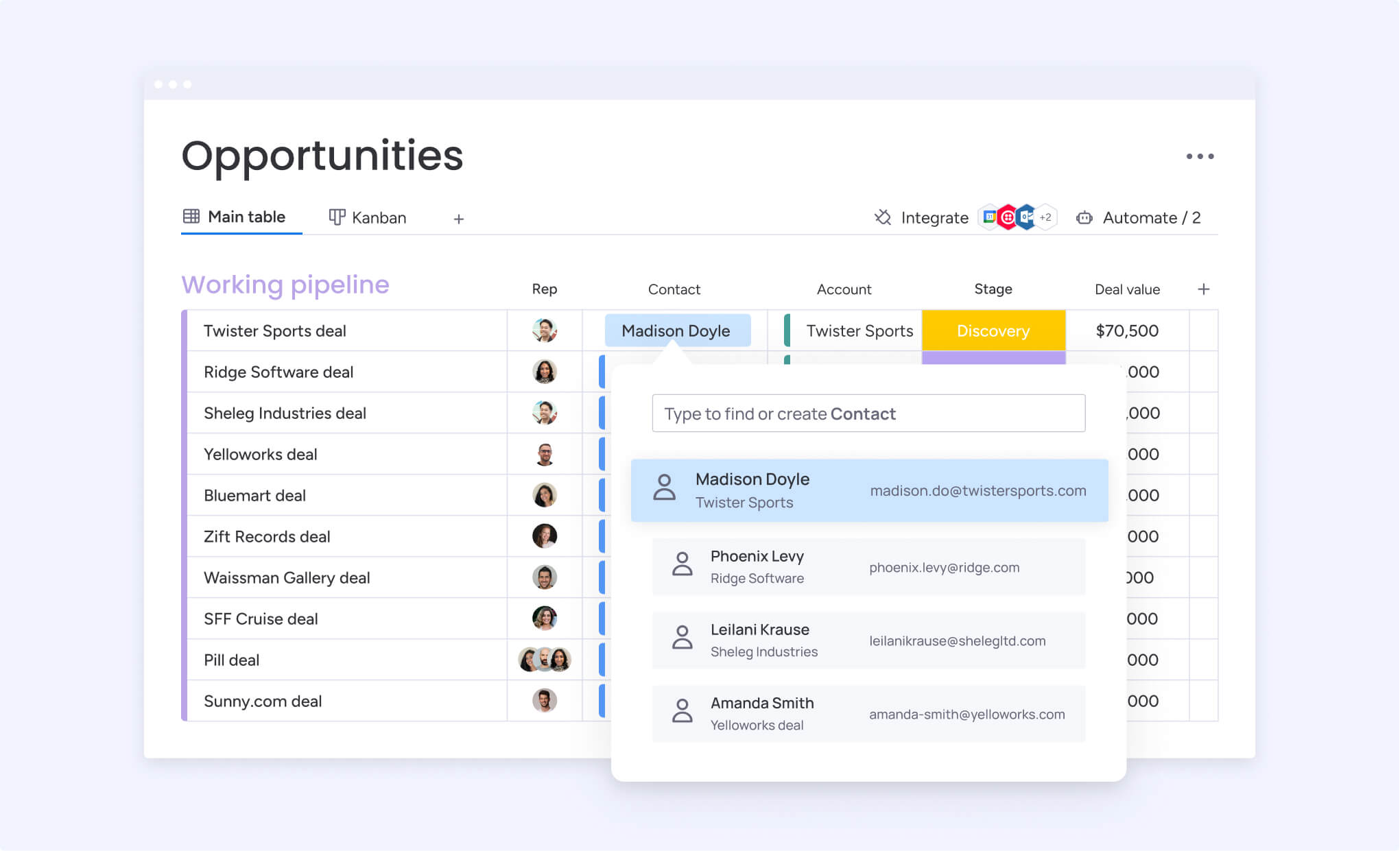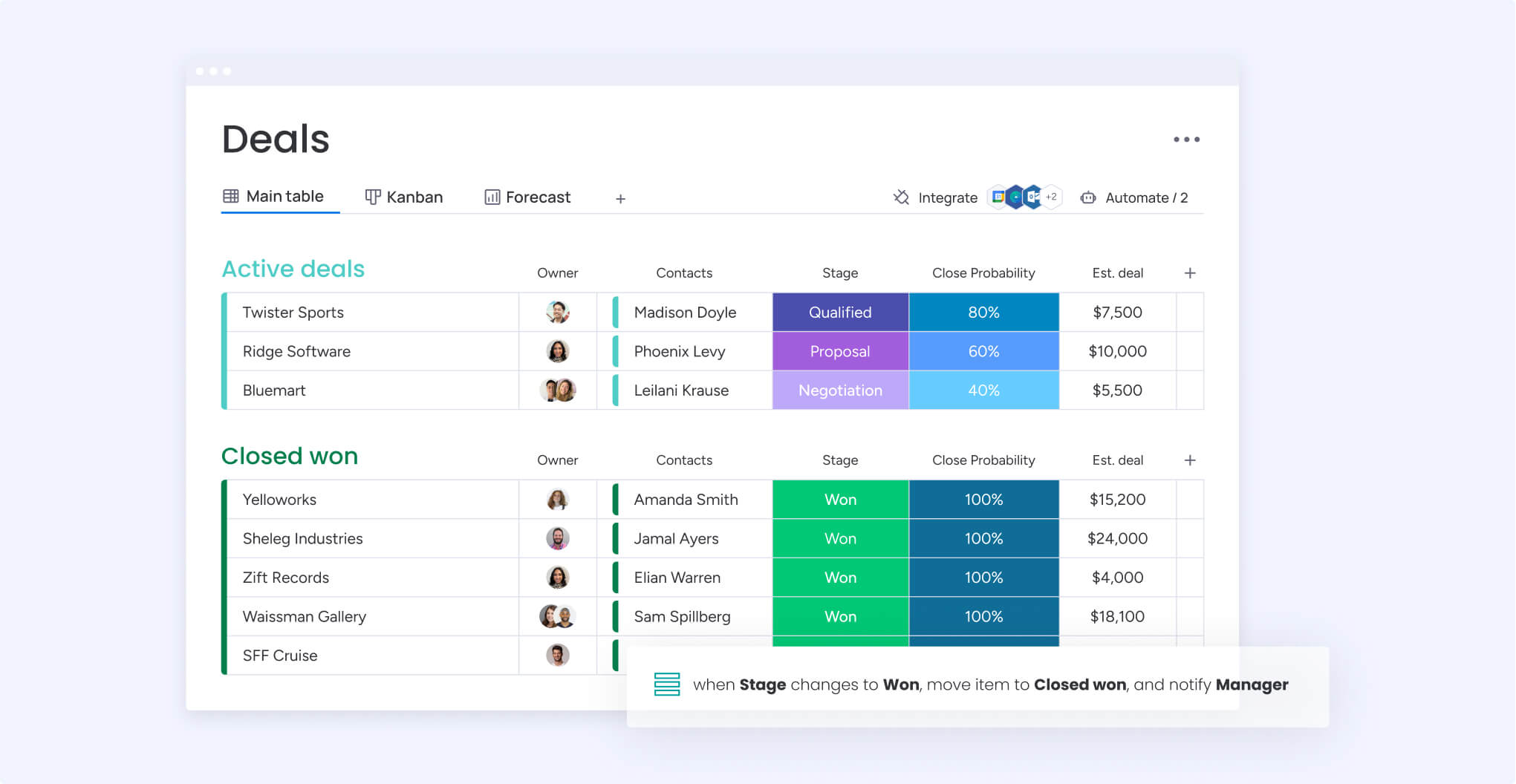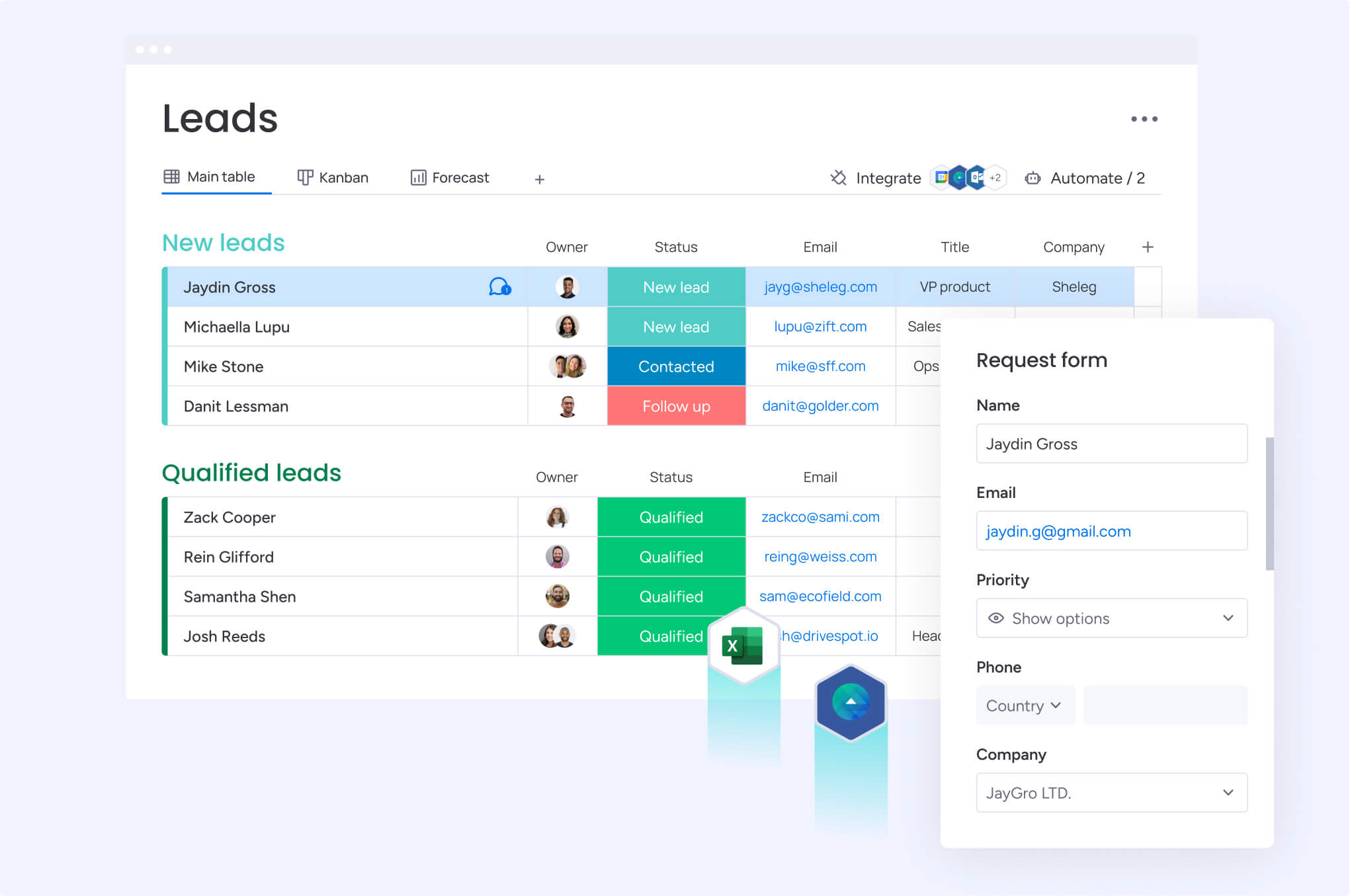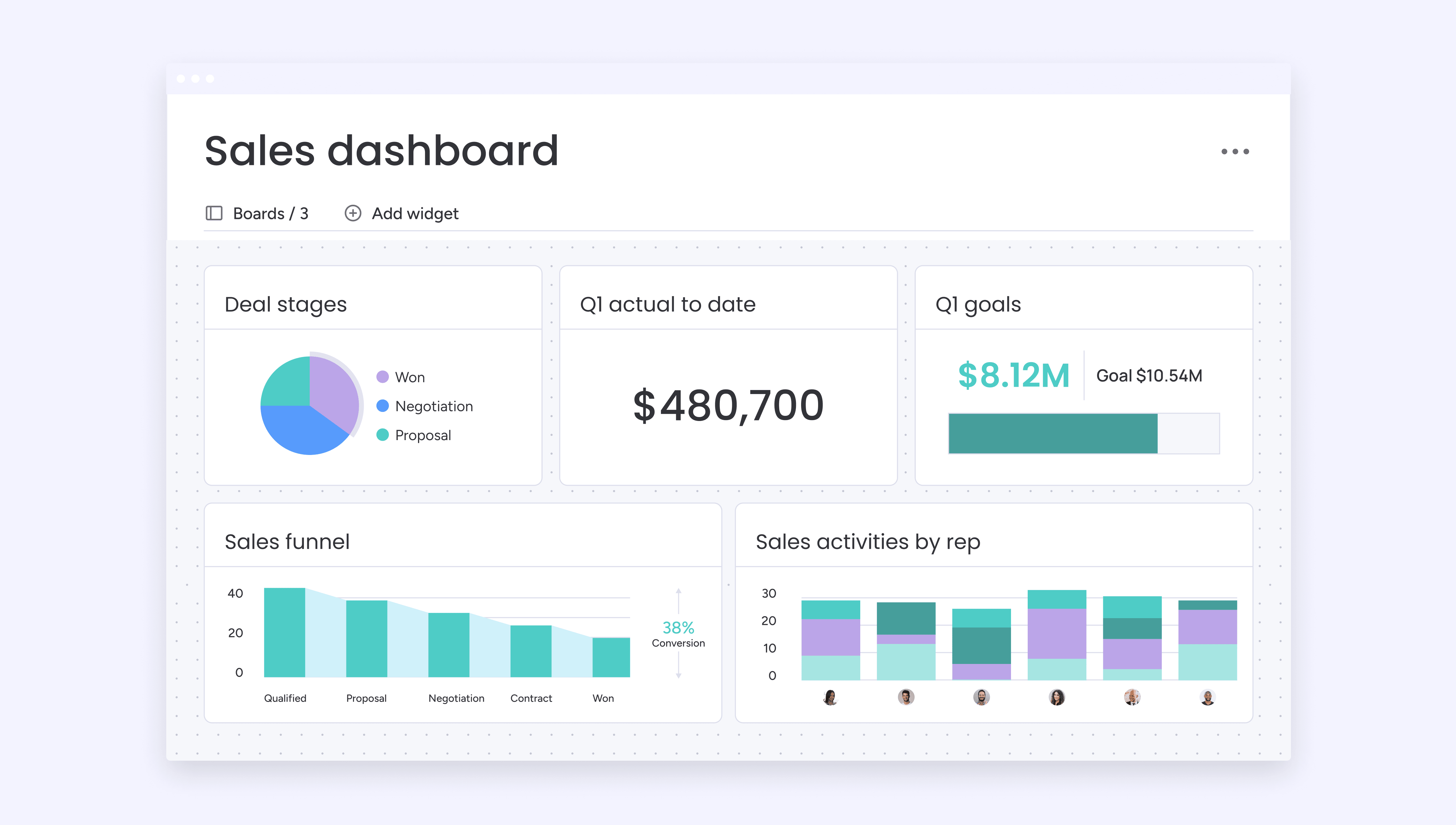What’s better for increasing sales: cross-selling or upselling?
The truth is that both are great sales strategies but should be used in different scenarios. In order to maximize revenue and improve customer satisfaction, using a mix of both strategies will help your business thrive. That said, it’s important to understand the difference between cross-selling and upselling to know when it’s best to employ each one.
In this blog post, we’ll look at the differences between the two, including when to use them, strategies for both, and how to use a platform like monday CRM to gather the data you need to make the most of your strategies.
Try monday CRMWhat is cross-selling?
Cross-selling techniques are used to encourage customers to purchase additional items related to an initial purchase. A classic example most of us are familiar with is stopping for a meal at McDonald’s. When you order a burger and the cashier asks, “Would you like fries with that?” that’s an example of cross-selling since she’s offering you an additional product that’s related to what you intended to purchase.
Benefits of cross-selling
- Boost average order value (AOV) and overall sales by encouraging customers to buy more
- Improve the customer experience by offering complementary products that increase satisfaction
- Strengthen customer relationships by showing them that you understand their needs with relevant product recommendations
- Increase loyalty and retain more business with a well-executed cross-selling strategy
Examples of cross-selling in different industries
- Retail: A shoe store suggesting socks or shoe care products when a customer buys new sneakers
- E-commerce: Complementary items shown at checkout or on a product page, like Amazon’s “Frequently Bought Together” section to recommend related accessories
- Financial services: A bank offering a credit card to a customer opening a checking account
- Software: A SaaS company suggesting an add-on, training program, or premium support package
What is upselling?
Upselling is a sales technique used to get customers to buy a more expensive or upgraded version of a product or service they’re already intent on purchasing. Take the same example of ordering a burger at McDonald’s. Instead of asking if you want to add to your meal, the cashier might ask, “Would you like to supersize that?” You’re still getting what you ordered, a burger, but the seller is trying to get you to increase your bill by adding another patty or increasing the burger’s size.
Benefits of upselling
- Increase customer lifetime value (CLV) by encouraging customers to invest in higher-quality products for long-term satisfaction
- Maximize revenue without spending on acquisition since it’s easier to increase sales from existing customers rather than relying on new ones
- Educate customers on premium products so that they understand the benefits of advanced features or higher-quality options
- Improve customer loyalty by showing customers the value of upgraded options so that they feel they can trust your brand
Examples of upselling in different industries
- Hospitality: A hotel offering a room upgrade to a suite for an additional fee
- Automotive: A car dealership recommending a higher trim level with added features like leather seats and a sunroof
- Streaming services: A platform like Netflix promoting a premium plan with 4K streaming and more simultaneous users
- Fitness industry: A gym offering a membership upgrade that includes access to personal training sessions
What’s the difference between upselling and cross-selling?
While both cross-selling and upselling are meant to increase a seller’s bottom line, there are differences in the way both of these sales tactics are approached. The table below illustrates the key differences between the two.
| Cross-selling | Upselling | |
|---|---|---|
| Goal | Increase the value of an initial purchase | Increase the total number of items in a purchase |
| Focus | Focused on additional products | Focused on a single product |
| Desired buyer action | Purchase additional products | Purchase a better or higher-quality version |
| Customer benefit | Enhance original purchase through additional products | Better experience through improved quality, features, or benefits |
| Customer research | Need to understand customers and their needs | Need to understand how to pitch higher priced item |
| Sales approach | Suggest relevant add-ons | Encourage upgrades or higher-tier options |
When to use cross-selling vs upselling
It’s important to understand when you should try to upsell a customer or when you should try to cross-sell complementary items. Applying both strategies simultaneously can feel like you’re pressuring a buyer, so it’s important to know when it’s best to use each one.
You should try and cross-sell a buyer when:
- You’ve already engaged with them and understand their needs
- You’ve gathered data about their purchase history, search history, and interests
- The additional product naturally complements the primary purchase
- The purchase journey allows for easy add-ons without overwhelming the buyer
You should attempt to upsell a buyer when:
- The upgraded product provides clear additional value or better features
- You believe a higher-priced product or service will lead to numerous benefits
- The higher-tier product aligns better with the customer’s long-term needs
- There’s a strong differentiation between standard and premium offerings
At the end of the day, your sales team should be trying to cross-sell or upsell each and every customer since it’s impossible to predict which sales tactic will work on which client. That said, it’s important to draw the line between pushing products and upgrades on a buyer and showing them the real benefits of purchasing additional items or a higher-value product.
7 tips and strategies for successful cross-selling and upselling
Cross-selling is an important part of any successful sales strategy. With the right approach, businesses can increase their customer loyalty and boost profits. Here are some tips for successful cross-selling.
1. Use data and insights to learn what your customer base needs

To effectively cross-sell or upsell, you need to know your customers’ needs and preferences. Take the time to understand what they’re looking for as well as their budget. You can do this by creating a buyer persona, gathering data such as demographic information, or collecting customer feedback. Look at your satisfied customers’ previous purchases to understand what they shop for so you can tailor your sales approach to each customer.
A CRM like monday CRM can help you collect, organize, and manage all this customer data so that it’s easily accessible when you need to pitch a customer or build a sales strategy. With a CRM, you can make sure products or services you’re upselling or cross-selling are personalized and relevant to each and every customer.
Try monday CRM2. Understand the customer journey
Understanding a customer’s buying journey helps cross-selling by allowing businesses to identify opportunities to offer complementary products or services throughout the customer experience. By evaluating the customer’s buying pattern, needs, and behavior, businesses can more accurately determine which products or services could be beneficial to them and the best time to pitch them. Building a customer journey map is a good way to understand when to cross-sell the most relevant products or services.
3. Identify related products and upgrades
Before putting any sales strategy into motion, you first need to identify which products to cross-sell with each purchase and how to upsell to a higher-ticket product.
When cross-selling, it makes sense to offer related items, for example, a laptop case if a customer purchases a laptop. Another way to identify related items is to look at what items other customers have purchased together.
For upselling, you want to clearly state the added value of a higher-tiered item. As an example, if you’re selling software to a client and they want the basic package, you might want to tell them about how advanced features in a higher-tiered package can better help them reach their goals.
4. Train your sales team
For a sales representative to make the most of each sale, they need to deeply understand how to get to the core of customer needs. They also need to be very familiar with your company’s products and services so they know the best ones to offer in different scenarios.
Provide continuous training on topics like building customer relationships, product knowledge, and how to use data to learn more about client needs. It’s also a good idea to have feedback sessions with every sales agent to help them craft their sales strategy and understand how to personalize each approach.
5. Create bundles
Creating bundles can help cross-selling and upselling by enabling customers to purchase multiple related items at once, often at a discount, and thus make a larger purchase. Some brands have even seen AOV increases of 20% after implementing bundles.
This is common with software where multiple apps are grouped together in a bundle. For example, someone shopping for Photoshop might be enticed to purchase a bundle of Adobe apps for a slightly higher price. By bundling different apps together, Adobe is also introducing new products to customers that they may not have known about or been interested in buying on their own. This helps to increase the visibility of products, build awareness, and potentially drive more sales.
6. Use multiple channels
Cross-selling isn’t limited to just one channel. Use a combination of channels, including email, social media, and in-person sales, to reach customers and maximize your chances of success. Additionally, implementing sales scripts ensures consistent messaging across all channels, enabling your team to effectively communicate the benefits of cross-selling to customers.
Text messages have proven to be a cost-efficient and effective way to cross-sell and upsell. In fact, the open rate for SMS is 98% compared to email marketing, offering a unique opportunity to cross-sell by text. Social selling is another way to cross-sell items to your customers. When working with influencers for social proof, make sure to ask them to include supplementary products to promote.
7. Build trust and don’t oversell
When we think about upselling or cross-selling, it’s common to imagine a pushy sales agent trying to squeeze more out of every sale. Product recommendations for additional items or upgrades should be genuine and based on benefits, not on increasing the value of a sale.
It’s critical to build trust and rapport with a customer beforehand to really understand what they’re in the market for in detail. A good salesperson will understand a customer’s needs based on previous experiences and by anticipating requirements.
When trying to cross-sell or upsell, it’s better to focus on the benefits it can bring to a customer rather than additional features since this demonstrates you have good insights into what the customer is looking for and what solutions will really help them achieve their goals.
Get the insights needed to sell more with monday CRM
Cross-selling and upselling are both great strategies to use to grow your bottom line, but without the right data and insights to support sales strategies, you risk losing out on sales or even confusing your customers. To ensure you’re creating a solid cross-selling or upselling plan, gather customer information on a reliable CRM, like monday CRM, so that you can visualize customer journeys, gain valuable insights, and offer relevant products.
As CRM software, monday CRM empowers sales teams to collect the customer data they really need and create a single source of truth. This helps develop stronger relationships with customers, making it easier to offer the right products at the right time. Here’s a deeper look into how monday CRM can benefit sales teams and help them execute cross-selling and upseling strategies.
Dive deep into customer data

With monday CRM, you can collect, store, and access customer data all in one place. Whether from social channels, surveys, purchase behavior, or past communications, each customer profile is updated with relevant data that can help you offer tailored selling opportunities.
Save time by using AI to create reports and automations

monday CRM’s AI-powered platform helps your sales team cut down on manual tasks and save time on admin work by creating smart automations and reports. This way, sales agents can focus on building rapport with customers and learning more about what products or upgrades to offer while AI does all the heavy lifting in the background.
Gather data through customizable forms and surveys

Another way to better understand your customers and which products are relevant for them is simply asking them. monday.com offers a survey tool that presents the results as data for you to analyze and gather information about your clients and their needs and preferences. You can also integrate your existing third-party survey tools, like SurveyMonkey.
Get real-time insights into team performance with dashboards

Keep track of how your sales team is performing with customizable dashboards that are updated in real-time. Visualize sales activities as a team or by individual rep and identify areas where agents can improve their cross-selling and upselling strategies to continuously coach them and offer actionable feedback.
Make cross-selling and upselling a pillar of your sales strategy
Upselling and cross-selling can both be used as strategies to increase revenue and create more loyal customers, but only when based on reliable data and organized effectively. monday CRM provides your sales team with the data you need to understand your customers on a deeper level so that you can ensure you’re presenting them with the right products and benefits. With a well-planned approach, cross-selling or upselling can help you set your business apart from your competitors by creating a better experience for your customers.
Explore CRMs by industry: CRM for banking, CRM for insurance agents, CRM for construction
FAQs
How can you improve cross-selling?
Segmenting customers, personalizing offers, automating communications, and collecting and analyzing customer data will all help you identify and improve cross-selling opportunities.
How do you upsell a product?
For an upsell to be convincing, you need to show how it adds value. You can do this by highlighting its features and benefits and demonstrating positive reviews of the product. Additionally, you want to create a sense of urgency so that the customer acts quickly in order to take advantage of the offer.
How do you upsell a customer?
From a customer perspective, it’s important that sellers understand their needs and ultimate goals. That way, you can make personalized recommendations when upselling products that are more likely to be welcomed by the customer.
What are the disadvantages of cross-selling?
When done incorrectly and without attention to data, cross-selling can overwhelm customers with too many choices, leading to decision fatigue or cart abandonment. In some situations, it can also come across as pushy, reducing trust and customer satisfaction.
What is cross-selling vs upselling vs bundling?
Cross-selling encourages customers to buy related or complementary products, while upselling promotes a higher-end version of the same product. Bundling is a strategy in both where multiple products are combined into a single package at a discounted rate to increase value.
When should you upsell or cross-sell?
Sales agents should always try to upsell or cross-sell, but pay close attention that the added product or upgrade meets the customer’s needs and offers additional value. These sales strategies should enhance the original purchase and improve the overall experience.
 Get started
Get started 
